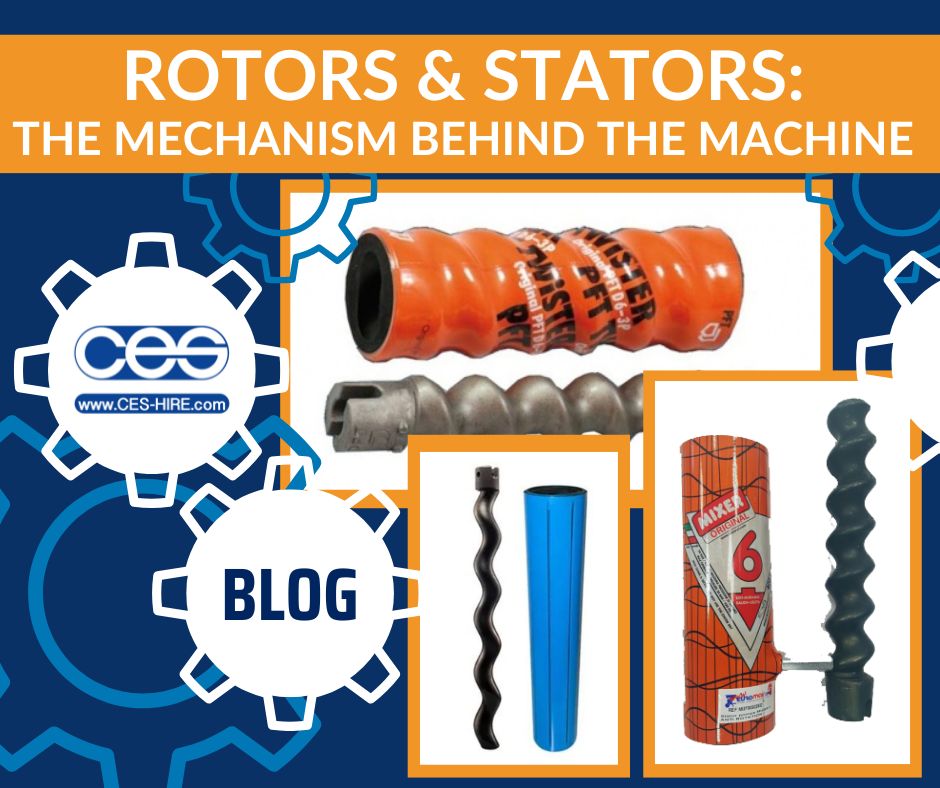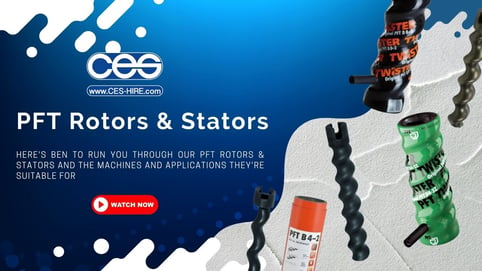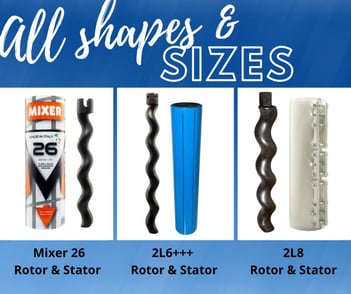There are a multitude of rotors and stators available so sometimes it can be overwhelming when selecting the right set for your machine. It is important to match the correct rotor and stator to your pump taking into consideration the material and aggregate size as well as the speed/pumping pressure. If you’re not quite sure which rotor and stator is right for you, always give us a call (01494 715472) and we’ll be happy to help. Or for further information, read on and we’ll shed a bit of light on the world of rotors and stators.
The Mighty Mechanism Behind the Machine
Many of our machines operate by rotor and stator mechanism. Product such as render, plaster, grout or liquid flow screed, is directed through the rotor and stator by a cardan or mixing shaft. The spiralled steel shaft is the rotor element and rotates inside the stator (the rubber lined stationery component) and creates conveying chambers. The conveying chambers move in the direction of flow and allow a continuous flow which pushes the material through the hose and out onto the surface. Rotors and stators vary in terms of speed and pumping/spraying output so it’s important to select the right one. Shop our range of rotors and stators here >
How do I know which Rotor & Stator fits my Machine?
If you’re not sure which rotor and stator fits your pump, the first place to look is on the product spec/data sheet. You will also generally find that the size of the rotor and stator often reflects the size of the machine. The enormous rotors and stators such as the 2L6+++ will fit big diesel machines, can cope with a larger aggregate size and will have a greater material output. A smaller rotor and stator is the opposite being compatible with smaller aggregate materials and achieving a lower material output.
Why are Rotors and Stators Different Sizes?
Rotors and stators come in a range of shapes and sizes for many reasons:
- To cope with different materials
- To pump at different pressures
- To pump at varying speeds
- To allow more control
- Personal preference when working
- To cope with larger jobs
On rotor and stator data sheets you will notice the specification is based on a standard speed on 400RPM. Quite often renderers will have a preferred rotor and stator which allows them to work at the speed that they have become accustomed too as well as have control over the time for the render to go off and subsequently be scraped/finished. You will also find renderers with greater experience may be able to work with a faster rotor and stator whilst still remaining in control. Sometimes the intricacies of a job will have a bearing on the rotor and stator choice since a block of flats with many windows may require more control than one large flat warehouse wall. When it comes to render you have to factor in time for the product to go off and whether you’re scraping the same day or the following day so your rotor and stator choice will need to be considered. Products such as liquid flow screed are pumped at a much faster speed as it sets between 30 minutes to an hour so time is of the essence and it important to fill the space as quickly as possible to ensure uniformity across the floor.
Size Matters
Whilst in general a larger rotor and stator fits a larger machine, it is not just the length and width to consider. The pitch (ridges) on the rotor have an influence on pumping speed and pressure. Rotors with more or deeper pitches will pump at a higher pressure. You will often need greater pressure if you are pumping further and have more hose to get the material through or perhaps are spraying a greater height. If your rotor has a shallower pitch (is less ridged), it will produce a lower pressure as the material slides through more easily with less ridges to navigate. Another element to consider along with the size is the shore or how soft/firm the stator (a higher number indicates a firmer inner tubing). A softer stator is often recommended for coarser material.
What if I fit the wrong Rotor and Stator?
Some machines have the capability for a number of rotors and stators to fit allowing the pump to be more versatile. This means your machine may be able to cope with a range of materials adjusting from render to liquid or latex flow screed with a simple rotor and stator change. A machine such as the Euromair MixPro 28 will give you this kind of versatility. Whilst some machines are compatible with several rotors and stators, it is vital not to fit the wrong rotor and stator to your machine. The incorrect part can cause serious damage to your machine. If you pump a material with aggregate that is too large for the rotor and stator you will potentially cause a blockage. If you don’t act on a blocked machine quickly and wash it out you can cause further problems and damage that can be expensive to repair. Another issue with pumping the wrong product with the incorrect rotor and stator is wear on your moving parts, larger aggregate pushing through a smaller rotor and stator will cause a huge amount of wear. Since these are expensive parts to replace, you don’t want to be replacing your rotor and stator after every single job.
For more information on rotors and stators specifically for rendering pumps check out our blog >






